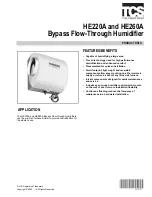
9
English
12. Cabling
Check that cabling will not be subject to wear, corrosion,
excessive pressure, vibration, sharp edges or any other adverse
environmental effects. The check shall also take into account
the effects of aging or continual vibration from sources such as
compressors or fans.
13. Detection of flammable refrigerants
Under no circumstances shall potential sources of ignition be used
in the searching for or detection of refrigerant leaks. A halide torch
(or any other detector using a naked flame) must not be used.
14. Leak detection methods
The following leak detection methods are deemed acceptable
for systems containing flammable refrigerants. Electronic leak
detectors shall be used to detect flammable refrigerants, but
the sensitivity may not be adequate, or may need re-calibration.
Detection equipment shall be calibrated in a refrigerant-free area.
Ensure that the detector is not a potential source of ignition and
is suitable for the refrigerant used.
Leak detection equipment shall be set at a percentage of the LFL
of the refrigerant and shall be calibrated to the refrigerant employed
and the appropriate percentage of gas (25 % maximum) is
confirmed. Leak detection fluids are suitable for use with most
refrigerants but the use of detergents containing chlorine shall be
avoided as the chlorine may react with the refrigerant and corrode
the copper pipe-work.
If a leak is suspected, all naked flames shall be removed/
extinguished. If a leakage of refrigerant is found which requires
brazing, all of the refrigerant shall be recovered from the system,
or isolated (by means of shut off valves) in a part of the system
remote from the leak. Oxygen-free nitrogen (OFN) shall then be
purged through the system both before and during the brazing
process.










































